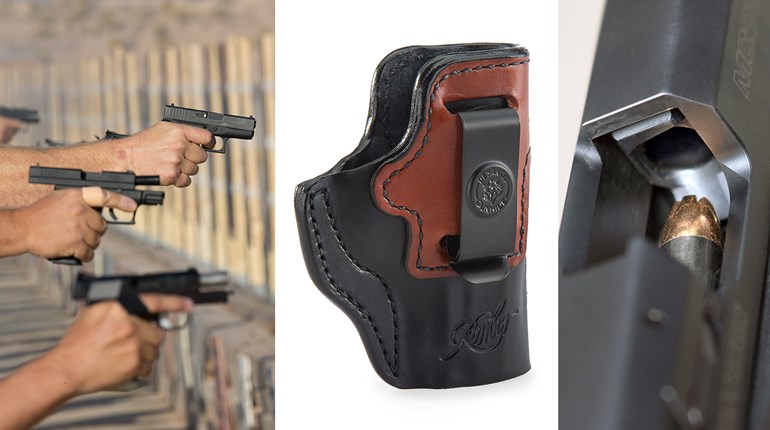
In 1904, U.S. Army Capt. John Thompson and Maj. Louis LaGarde shot steer and human cadavers for that purpose. Julian Hatcher, a former technical editor at American Rifleman, based his theory of Relative Stopping Power on this study and concluded the .45 ACP FMJ bullet is twice as effective as a 9 mm FMJ bullet.
In 1975, the National Institute of Justice finalized what it called the Relative Incapacitation Index, which was later updated in 1985. This study was based on hypothetical assumptions and a computer-generated man. The study rated the 115-grain, 9 mm FMJ round twice as effective as a 230-grain, .45 ACP FMJ.
After the tragic 1986 shootout in Miami, the FBI established its own testing methodology using 10-percent ordnance gelatin and various intermediate barriers. It concluded that for law enforcement, the minimum acceptable bullet penetration depth was 12 inches. Essentially, the FBI rated the .45 ACP twice as effective as the 9 mm and considered 147-grain 9 mm bullets much better than 115-grain bullets. Like with all theories, problems exist with the FBI's methodology. For example, it gives the 9 mm, 115-grain, Cor-Bon +P JHP load a wounding value of zero, seemingly suggesting you are no worse off after one of these bullets hits you between the nipples.
In 1991, a privately funded research group began studying the physiological effects of bullet impact on medium-sized animals. The primary objective was to isolate the physical mechanism responsible for rapid incapacitation of man-sized targets. This became known as what some consider the mythical—meaning, never happened—Strasbourg Tests. Supposedly, 611 goats were terminated, generating 580 valid tests, providing average incapacitation times for the most popular defensive handgun loads at that time.
The Strasbourg Tests had two important findings. First; frangible bullets like the Glaser Safety Slug and hollowpoints that violently expand and transfer a great deal of energy very quickly produce the fastest incapacitation times. Second; when bullets impact ribs—this happens about 50 percent of the time in defensive shootings—incapacitation times are usually increased.
Also in 1991, the Naval Weapons Support Center tested 10 different 9 mm loads, seeking the best hollowpoint for use by the Naval Criminal Investigative Service. Along with terminal performance and reliability, accuracy was also evaluated. Unlike the FBI, the NWSC used 20-percent ordnance gelatin because it was determined by the Wound Ballistics Lab at the Letterman Army Institute of Research to offer the best simulation of muscle tissue. With the assumption that penetration beyond 12 inches would be hazardous to bystanders, they concluded Federal's 147-grain JHP was best. But, the results were heavily weighted by the somewhat impractical reliability function tests in their handguns.
Surprisingly, all Federal agencies do not follow the FBI's lead with regard to ammo selection. In 1987 the Secret Service also commissioned a study of 9 mm ammunition. It was based on a bullet's ability to deposit energy in the first 5.9 inches of 20-percent ordnance gelatin. The supporting logic was that the greater the energy deposit, the greater the potential for tissue damage. The best performing 9 mm load in this test was Winchester's 115-grain +P+ JHP.
All this illustrates how nobody seems to agree on anything, well hardly anything anyway. The problem is, humans cannot resist the urge to rate everything from football teams to members of the opposite sex with numbers. College football fans know how effective the BCS rating system is; top ranked teams are beat by unranked opponents every week and there's little consensus on whether Britney Spears is a five, eight or 10. Shootings are chaotic events, and numbers cannot effectively value chaos. No matter the criteria, the bias of evaluators always creeps in the equation and anomalies always exist.
Which study do you believe? What cartridge/load do you select? You can do the research and conduct your own tests. I have, and I strongly encourage it because you will learn stuff. I even have my own theory, but guess what? It's no more valid than any of the others. Some cartridges and bullets are better than others and we will continue to examine those differences in this column. Still, there is nothing wrong with a practical approach, consistent with the doctrine: Keep it hillbilly simple. Here are three rules that reflect that mindset.
Rule No. 1: Carry the largest caliber, highest-capacity handgun you can comfortably conceal on a daily basis.
Rule No. 2: Load it with flawlessly functioning ammunition, utilizing an expanding/fragmenting bullet, delivering high energy levels for your cartridge.
Rule No. 3: Prove you can use that combination to put six shots in a 10-inch circle at 10 feet in less than 3 seconds.
For further reading check out "Handgun Stopping Power," "Street Stoppers" and "Stopping Power" by Evan Marshall and Ed Sanow. The philosophy of Marshall and Sanow is that the best way to evaluate handgun stopping power is by looking at actual street results. You may not agree with their findings, but the information on cartridges and bullets, various testing methodologies and the very interesting tales from the street are worth the price of admission. All three books are available from Paladin Press and are packed with plenty of statistics, data and photos to help you argue about what's best with ballisticians, blowhards and bullet geeks like me.






































